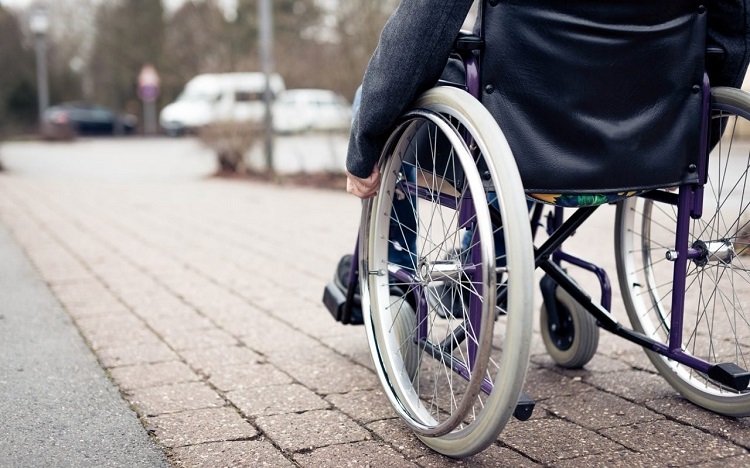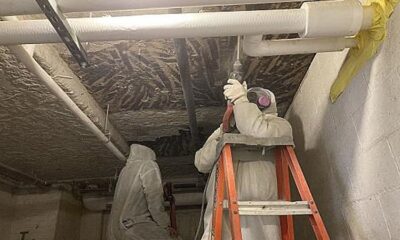Health
Out Damn Spot: 5 Skin Conditions that Are Easier to Treat Than Ever

If you suffer from dark spots, acne, or premature skin aging, you likely know these skin conditions. However, that doesn’t lessen the negative effect they can have on your self-confidence. You deserve to feel beautiful from the inside and out. And the good news is that this article can help you do just that. Here, we highlight a few common skin conditions and treatments you should consider:
Table of Contents
1. Melasma
Melasma is a common skin condition, especially for women. It causes dark-colored patches and spots on the skin, usually on the face, cheeks, and forehead. Several things can trigger melasma. For one, pregnancy. During pregnancy, your hormone levels fluctuate, which can cause melasma. Melasma can also result from sun damage, stress, certain health conditions — like thyroid disease — and some medications.
In some instances, melasma goes away on its own. This is especially true for pregnant women. Once their hormone levels stabilize, the melasma typically fades. Unfortunately, that’s not always the case. For some, the discoloration remains and can be challenging to treat. But that doesn’t mean it’s impossible.
There are several treatment options for those with melasma, including topicals. A few popular ones are hydroquinone, tretinoin, and azelaic acid. All are science-backed treatments used to treat melasma and other types of hyperpigmentation. Speaking with a medical provider can help you determine which option could be right for you.
2. Adult Acne
If you suffer from acne, you’re not alone. Acne is one of the most common skin conditions in the world. In fact, acne affects about 50 million Americans annually.
Contrary to popular belief, acne doesn’t just impact teenagers. Adults, regardless of gender, can have acne. It’s called adult acne or post-adolescent acne and can be caused for many reasons. Adult acne has indirect and direct factors, from hormones to hair products and diet. Some medications can even cause acne.
If you’ve tried product after product to no avail, you may want to consider taking a different approach. For one, stop buying skin care products based on what’s advertised in the media. It’s important to remember that advertisements and influencers are getting paid to talk about specific products.
Not to mention, everyone’s skin is different. What works for one person’s skin may not work for yours. That’s why you should focus on finding products for your specific skin type rather than what’s trending. Similarly, you may need to consider your diet. Not all foods agree with all people. If you eat a lot of sugary and greasy food or dairy, that may be what’s causing your acne.
3. Sunspots
Sunspots are another common skin condition. They are usually flat, dark spots that appear on areas commonly exposed to the sun, such as your face, arms, or chest. While these spots are typically harmless, they can be a nuisance. If you have sunspots, you’re probably ready to make them disappear, right? Well, good news, there are ways to fade those unsightly spots.
A great way to get rid of sunspots is to prevent them in the first place. To do that, make sure you reduce your exposure to the sun. Wear a brimmed cap when you go outside. And don’t forget to apply a broad-spectrum sunscreen with an SPF of 30 or higher.
Another option for getting rid of sunspots is a chemical peel. Chemical peels work by exfoliating the top layer of skin. This removes damaged cells (like those causing sunspots) and replaces the skin with healthy cells. In addition to fading dark spots, chemical peels also lessen the appearance of fine lines and improve the skin’s overall texture.
It’s important to note that chemical peels have different strengths, from light to medium to deep. If you have sensitive skin, you should opt for a light chemical peel, so you don’t notice any adverse side effects.
4. Rosacea
Rosacea is a skin condition usually on the face that causes redness and small pus-filled bumps. It’s most common in middle-aged women and often starts with a tendency to blush. While rosacea is harmless and not contagious, it’s prevalent. According to the American Academy of Dermatology, it impacts 16 million people in the United States annually.
Unlike other skin conditions, the symptoms of rosacea ebb and flow. But even only occasional flare-ups can be bothersome. Having this condition doesn’t necessarily mean your face constantly looks flushed. Luckily, there are treatment options available.
Rosacea is often associated with immune system disorders, like allergies to a particular food. Because of that, consider changing your diet to avoid foods that cause flare-ups. Making other lifestyle changes, like minimizing stress, wearing sunscreen, and quitting smoking, can also help reduce inflammation-causing rosacea.
5. Premature Aging
As you age, your collagen and elastin levels decline. This causes the skin to weaken and lose its firmness and strength, leading to wrinkles and fine lines. It’s important to remember that aging skin is a natural part of life. Unfortunately, some people notice their skin aging earlier than they’d like. Sound familiar? If so, you may be experiencing premature skin aging.
Premature skin aging is typical and has several different causes. Too much exposure to the sun, smoking, an unhealthy diet, poor sleep, stress, and too much alcohol can all add years to your skin. Certain skin conditions, like age spots, can also make your skin look older.
Thankfully, you can take steps to reverse the signs of premature aging. For one, it’s a good idea to limit your time in the sun. You should also consider adopting a healthier diet and eating food rich in antioxidants, like fruit and vegetables. Certain skin treatments, like dermal fillers and laser skin resurfacing, can also help reverse signs of aging.
Everyone wants flawless skin. And while there’s no such thing as the “perfect complexion,” it’s essential that you feel confident in your appearance. The tips above can help you, if you choose the best approach for the condition you want to target.
Health
6 Reasons Why the Fitness Industry Will Continue to Grow

It wasn’t long ago that personal training was seen as new and innovative. Finding a gym was a challenge back then, as only a small, dedicated group of fitness enthusiasts joined such clubs. Today, the fitness industry has surged into a billion-dollar market. Whether someone wants to sign up for cycling classes, schedule personal training sessions, or hit the gym at three in the morning, they can do so effortlessly.
Those considering a career or investment in the fitness industry might wonder if it has peaked, but that is far from the truth. In reality, the fitness industry is poised for even more growth. Here are six compelling reasons why this is the case:
Table of Contents
1 – Age Matters in a Good Way
You may have noticed advertisements for workout programs and group classes targeting older adults. While it’s true that age can affect physical abilities, exercise tailored to older individuals can improve mobility and stamina. Reaching a certain age doesn’t have to be a barrier to signing up for fitness programs—instead of tuning out, it could draw people in. This alone could significantly expand the potential customer base in the coming years.
2 – Growing Industry Diversification
The fitness industry now offers various unique studio options to suit different preferences. There are powerlifting gyms for strength enthusiasts, 24/7 commercial gyms designed for the average person, and boutique fitness studios tailored to specific goals. Finding a fitness option that meets your individual needs has never been easier.
3 – People Are More Concerned About Their Health
When people want to maintain their health, the fitness industry benefits. In the past, many people smoked heavily and lacked an understanding of nutrition and exercise. That’s less true today, as people recognize that a long, healthy life requires mind and body care. Signing up for an effective fitness program supports this goal.
4 – Technology Helps Fuel Interest
Those who think smartphones hinder an active lifestyle are mistaken. Countless downloadable apps can be invaluable for working out or staying in shape. From apps that track calories to those that help design proper workouts, technology can spark greater interest in fitness. Many fitness professionals even use platforms like YouTube or social media to offer distance training and attract clients.
5 – Wellness is Everywhere
Not only are there fitness apps to download and health-centric television shows to watch, but you might also have the opportunity to enroll in a corporate wellness program at your job. With health and fitness consciousness virtually everywhere, it is hard for the industry not to continue its growth.
6 – Mental Wellness Becomes Part of Fitness
The mental benefits of working out and exercising complement the physical ones. Consider that a reason why yoga and pilates are so popular. The more people learn that fitness activities can help reduce stress and improve mental wellness, the more the fitness industry will grow.
Those interested in starting a new fitness program have many ways to do so. Whatever path they choose, they will help keep the fitness industry on solid footing both in 2025 and for decades to come.
Health
Your NDIS Plan: 3 Tips To Get The Most Out Of It

It’s only natural that many Australians get overwhelmed by their National Disability Insurance Scheme(NDIS) plan. It’s full of complex jargon that covers every intricacy and this can be daunting for many people. But it doesn’t have to be that way! For starters, it’s important to know that there is help available, and help that can help you get the most out of your plan:
Table of Contents
There is help available
The best NDIS provider Mentone has will tell you that there is always help available. In fact, there are thousands of professionals across the country whose job is to help everyday Australians comprehend and navigate the system. They are called support coordinators and they will help you comprehend and get the most out of your plan.
They are your go-to in a moment of confusion, your bastion of understanding at the times you just want to fling the documents onto the floor. What’s more, there are also plan managers and service providers who can continue the given assistance.
When it comes to your plan you are certainly not alone. You likely weren’t expecting to have a plan any time soon so you’re not expected to understand all its complexities. Therefore, it’s always a good idea to reach out to a support coordinator or plan manager for advice – they will walk you through all the annoying jargon that can make this whole thing an apparently frustrating burden.
The NDIS is just one of those things that some people have a greater working knowledge in – there is nothing wrong with not fully understanding your plan and there is help available!
Begin with your goals
It’s a near-impossibility to simply list all of the supports you might need in daily life. This is because there are many different ways in which support might be required: food, cleaning, medication and the list goes on.
Therefore, one of the best ways to determine your needs is through determining your goals: what do you look to achieve through your plan? And, importantly, what you need to go from where you are now to a point where you believe you’ve reached your goals. This will help guide an idea of what support you will need for your plan. What’s more, the NDIS and its support coordinators, plan managers etc. can help you define your goals and, consequently, your support structure.
Don’t worry – whilst this process may seem overwhelming at first, you will reach a point where it makes sense and your goals and support requirements are clearly defined.
Work towards comprehending your plan
Before finalising your plan it is certainly a good idea to understand every aspect your plan can cover and what support opportunities are available. Your supports will be organised under a range of categories under the varying funding options. Each support category relates to a particular plan outcome that relates to your goals and how you would like to achieve them.
They can cover expenses you may not be aware of, so it’s always a great idea to have a thorough read about each category and what supports might be more beneficial than others. Once again, there are experts on-hand who will help you understand each and every category. They can ensure that you choose the support categories that are most suitable for your needs and goals.
Basically, the main thing is not to stress – there is help available! They will ensure that you get the very best cover with your disability insurance scheme plan and that you have the right team looking after your needs.
Health
Reducing Healthcare Costs With Quality Nursing

It’s a well-known fact that the American healthcare system is one of the most expensive in the world, for individuals, pharmaceutical companies, hospitals and terminally ill patients.
In 2021, America spent about $4.25tn on healthcare, making the United States healthcare system one of the most expensive in the world. The country is trying to curb these soaring costs with various strategies, including optimizing the role of registered nurses (RNs) in providing cost-effective healthcare services.
RNs play a vital role in providing high-quality, affordable care. They are skilled professionals who can reduce the occurrence of costly medical mistakes. Reputable institutions, such as Wilkes University, offer an accelerated nursing program for those who have earned a bachelor’s degree in another field and are looking to transition into nursing. Wilkes University accelerated nursing program is fully accredited by the Commission on Collegiate Nursing Education and uniquely structured with only two terms in a year to help nurses balance other commitments. This program can help nurses build strong career foundations, including understanding the cultural and economic factors of treating diverse patient populations.
Below, we discuss some of the ways registered nurses can provide cost-effective healthcare services to patients, regardless of age.
Table of Contents
Ways that registered nurses provide cost-effective care
Registered nurses have expertise and commitment that can contribute to improved health outcomes and reduced healthcare costs. Here are some of the ways they can do this:
Preventative care efforts
RNs provide cost-effective care through several preventative care efforts. They focus on educating the community by promoting a healthy way of living. They also promote mental health awareness, and early detection of health conditions. These efforts can help to reduce healthcare costs and improve patient outcomes.
When educating communities, RNs actively engage with the public to disseminate vital health information. They may conduct health workshops or seminars on topics such as nutrition, exercise and the dangers of smoking. For instance, a nurse may lead a community program to discuss the importance of a balanced diet and regular exercise in preventing obesity and the associated health risks. Outreach efforts like this will help inform people about what they can do to improve their health. This, in turn, reduces unnecessary visits to the hospitals. After all, well-informed individuals are more likely to engage in preventive health practices than individuals who aren’t.
Health promotion is another crucial area where RNs contribute. They initiate and participate in various programs, including vaccination campaigns and wellness workshops, in schools, workplaces and clinics. A nurse may volunteer to talk to high school students about the importance of hygiene. They may visit workplaces or meet parents at daycares to raise awareness of the benefits of preventive measures, such as immunizations, which can significantly reduce the incidence of infectious diseases.
In addition, screening and early detection of diseases are vital to how effectively RNs can provide preventive care. Regular screenings for conditions such as hypertension, diabetes and cancer can help nurses detect signs and symptoms and offer appropriate care before the condition worsens. If a registered nurse were performing routine blood pressure check on Mr. John who comes for a weekly check-up on his blood glucose level, and noticed his blood pressure was through the roof.
After discussing with Mr. John the things he can do to avoid a hypertension diagnosis. The nurse may also arrange for a prescription to help him regulate his blood pressure. In addition to improving his health outcomes, it also significantly reduces the cost associated with treating advanced complications caused by untreated high blood pressure. The nurse can also teach him how to monitor his blood glucose levels so he doesn’t need to visit the hospital as often.
Health education
Nurses amplify the impact of health education, especially in areas such as chronic disease prevention, where they skillfully guide patients with chronic conditions through the complexities of self-management. They’re usually patients’ regular point of contact and are responsible for caring for them. Helping them find better ways to cope with their condition falls under this responsibility.
A nurse working with a patient suffering from chronic respiratory issues may develop a customized plan to monitor and manage symptoms, which can reduce the risk of severe episodes. This nurse may also curate a plan for patients with diabetes and hypertension, with practical advice on how they can integrate these routines into their lives. This way, nurses can empower their patients and minimize the need for frequent hospitalization, which is a win-win.
RNs also provide lifestyle counseling. This goes beyond the traditional medical approach. Instead, they delve into the nuances of nutrition, physical activity, stress management and how to stop smoking. To assist patients, they may offer tailored dietary advice or design an exercise regimen for patients at risk of lifestyle-related diseases.
Nurses don’t just dish out medications and send the patient home; they talk to them about the dangers of their lifestyle as it relates to their condition. They may help a patient see that their smoking could lead to lung cancer, which may jeopardize their health and lead to added healthcare costs.
Effective resource utilization
Nurses have an uncanny ability to use resources judiciously. Their ability to manage whatever resources they have while ensuring that every patient receives proper healthcare services is why RNs are at the top of cost-effective approaches.
Nurses ensure the optimal use of resources. This may include properly organizing and tracking medical supplies to ensure they don’t waste or over-order them. This kind of inventory management can help, especially in healthcare settings where every item counts.
While medical resources are essential, nurses are also well-versed in maximizing human resources. These professionals ensure that patient care is streamlined and efficient by collaborating with other healthcare professionals, including doctors, therapists and pharmacists. This is evident in care coordination, where nurses facilitate communication among specialists. They do this to ensure each patient’s care plan is effectively implemented and that tests and procedures aren’t duplicated unnecessarily.
Nurses are the first healthcare professionals that patients often interact with. This means they must cater to the patients, carry out initial assessments and triage cases to know which ones are to be prioritized. Triaging can help reduce waiting times and ensure patients receive timely care. They may also educate patients with non-urgent cases on handling similar situations at home. The goal is to minimize the need for frequent hospital visits, and what better way than to teach individuals how to perform first-aid treatments on a scraped knee?
Pain management
RNs tackle pain management through multimodal approaches. Multimodal pain management typically means combining medications, physical therapies and alternative therapies to treat a patient. It’s an integrated approach that addresses pain from different angles. It aims to minimize patients’ reliance on opioids, which could lead to addiction and side effects. Instead, it focuses on the other factors that could be contributing to their pain, and alternative ways to work on those factors.
Medications in a multimodal plan might include non-opioid pain relievers, anti-inflammatory drugs and muscle relaxants. RNs closely monitor the patient’s response to these medications and adjust dosages to help the patient control their pain as much as possible.
They also utilize physical therapy. RNs meet with physical therapists to develop and implement exercise plans tailored to the patient’s condition and pain level. These exercises can serve various purposes, including increasing mobility, strengthening the patient’s muscles and reducing pain. For example, a patient recovering from surgery may be guided through specific exercises to help them manage postoperative pain and speed up their recovery.
RNs also integrate alternative therapies into their strategies. Alternative treatments may include acupuncture, massage therapy and relaxation techniques. A patient with chronic back pain may benefit from regular massage therapy sessions and relaxation techniques such as meditation.
The goal of pain management without using opioids is to help patients control pain effectively while reducing the risks that come with using addictive pain medications. Reducing patients’ reliance on opioids also means the likelihood of the patient being readmitted to the hospital due to complications, such as addiction, is slim. Alternative approaches can also be more cost-effective long-term because they address the pain’s root causes and contributing factors, which leads to more sustainable outcomes.
Remote monitoring
Most medical professionals are embracing telehealth. According to a survey by the American Medical Association, 85% of physician respondents now use telehealth or a mix of physical and virtual visits, and about 44% of respondents indicated that telehealth reduced the cost of care.
The healthcare system has been revolutionizing healthcare delivery with remote monitoring. This approach has been instrumental in helping patients manage chronic conditions. Chronic conditions require regular monitoring, which can be challenging for patients who need frequent hospital visits. Telehealth addresses this by allowing consistent monitoring without physical travel.
Telehealth offers RNs a platform for patient education and self-management. Nurses can use virtual consultations to instruct patients on managing their conditions, using medical equipment and adhering to medication schedules.
RNs can also remotely monitor vital signs and symptoms, whether it’s through video calls or voice calls. It is easier to provide immediate advice to a diabetic patient whose blood sugar has spiked through a quick call than having them drive miles to the hospital to get the same advice. This is also especially beneficial to elderly patients and patients in rural areas with limited healthcare access.
Reducing the need for physical consultation will reduce healthcare costs for patients and providers. The patient doesn’t need to spend as much on transportation and consultation, and the clinic can better utilize resources for patients who need immediate in-person care. It also removes barriers such as geographical isolation and mobility issues, making healthcare more accessible to a broader population.
One of the major advantages of telehealth is its potential to reduce hospital admissions. RNs can monitor their patients continuously to prevent health issues from escalating to the point of hospitalization. This improves patient outcomes and helps the healthcare system optimize resource utilization.
Care in the community
Registered nurses now visit patients in their homes. They deliver care directly to patients in their homes. This helps to reduce the duration and frequency of hospital stays and long-term care facility admissions. Patients receiving care in their homes can significantly enhance their comfort and quality of life. It allows them to stay in a familiar environment, which can be particularly beneficial for the elderly, chronically ill and those requiring palliative care.
Home health nursing also facilitates personalized care tailored to each patient’s needs. RNs can closely monitor their patient’s condition, adjust care plans in real time and provide one-on-one attention that might not be as readily available in institutional settings. This approach supports the patient’s independence and can encourage the family to become involved in the patient’s treatment. This is crucial for emotional support and the patient’s well-being.
Patient safety
Patient safety has two crucial compartments: infection control and fall prevention. Registered nurses use several protocols to ensure infection control in their clinics and hospitals. These protocols may include using hand sanitizers for hygiene, personal protective equipment and proper sterilization of medical equipment. These protocols not only help reduce the incidence of infections; they also reduce the number of times patients stay in the hospital and avoid unnecessary hospitalization.
Every visitor, patient and hospital staff member is protected through these preventive measures. This means no patient spends more time in hospital than necessary, and staff do not become ill because of the lack of those protocols.
Registered nurses also prevent older and vulnerable patients from falling. It’s common knowledge that falling can lead to serious complications and potential long-term hospitalization. Hospitals try to avoid this by having registered nurses provide assistive devices and environmental modifications. This may involve avoiding the use of stairs for some patients.
Nurses also educate elderly and vulnerable patients about how to avoid falling in any scenario. This provides patients with information on navigating their way around the hospital premises safely.
A crucial role
Registered nurses spearhead health promotion, early disease detection and excel in telehealth, significantly reducing healthcare expenses. In community and home health settings, their focus on patient safety and infection control cements their value in the healthcare system.

 Business2 years ago
Business2 years agoSeven Ways A Degree In Social Work Impacts The Society

 Social Nerworking6 years ago
Social Nerworking6 years agoFacebook’s Movie Ads now includes Ticket and Showtime Details

 Games4 years ago
Games4 years agoWhat Makes Block Games Different?

 Technology2 years ago
Technology2 years agoBest Messenger Bot Agencies in 2020

 Foods2 years ago
Foods2 years agoDifferent Types of Bakery Products

 Games2 years ago
Games2 years agoSubway Surfers Hack: Tips and Tricks to Hack for Android/iOS

 Business2 years ago
Business2 years agoWhat Is Cloud Customer Service?

 Games2 years ago
Games2 years ago6 Top-Notch Games Like IMVU





































You must be logged in to post a comment Login